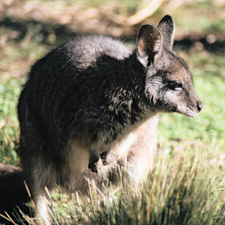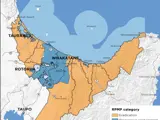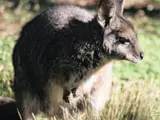 Wallaby
Wallaby
Common name: Dama Wallaby (also known as Tammar, Silver-grey or Kangaroo Island wallaby)
Botanical name: Macropus eugenii
Management programme: Eradication, Progressive Containment
Where did they originate from?
- From Australia where they were formerly widespread in southern mainland Australia.
- Dama wallaby (and four other species of wallaby) were first introduced to Kawau Island by Sir George Grey in 1870, along with monkeys, zebra and gnu.
- In 1912 Dama wallaby, from Kawau Island were brought to the Bay of Plenty and released near Lake Ōkāreka. Since that time they have become established over approximately 200,000 ha.
- Following eDNA research conducted by Biosecurity New Zealand in 2023 it was determined that parma wallabies are also present in the Bay of Plenty.
Why are they a pest?
- Wallaby feed on native tree seedlings, ferns and grasses to such an extent that over time they limit the regeneration of some species, altering the structure and composition of our native forests. Some of the species selectively browsed by wallaby are important as a food source for native birds and wildlife.
- In exotic plantations wallaby can damage pine and eucalyptus seedlings.
- On farmland they compete with stock for pasture.
Where are they found?
- As wallaby are cautious and nocturnal (they seek shelter during the day in dense forest or scrub), they can be difficult to detect.
- Wallaby can be found in both native and exotic forest, preferring habitat with access to pasture and/or sunny clearings. They often congregate in small family groups.
- Wallaby spread has been slowed by physical barriers such as lakes and rivers. In some cases, dispersal beyond these barriers has been aided by people.
- Their current distribution lies from Rotorua east to Kawerau, and south beyond Rainbow Mountain to the Paeroa Range (between Reporoa and Waikite Valley). See the map below.
What do they look like?
- Dama wallaby are one of the smallest wallaby species, standing only half a metre tall. Mature males weigh around 7kg while most females are less than 5kg.
- They are grey-brown in colour with a paler grey underbelly. A thin white-silver stripe runs from under the eye to the nose.
- Mature animals may have a patch of reddish-brown fur across their shoulders.
- They are a marsupial that carries their young around in a pouch.
- Females give birth from January to February. Young stay in the pouch for 250 days.
Field sign
- In areas of sand or soft soil, the long narrow hind feet, and occasionally the tail, leave a characteristic track.
- The footprint of a wallaby is a two-pronged print with a large central toe extending further than the outer toe. A tiny double clawed toe on the inside of the hind foot does not touch the ground so it doesn’t normally feature in the print.
- Their faecal pellets are also distinctive, slightly larger than an individual deer pellet and often tear-drop shaped.
What are the rules?
Eradication
Eradication pests are present in the region but are limited in their size or extent of infestation. The eradication of these organisms is a feasible and cost-effective solution. The Bay of Plenty Regional Council is responsible for their control or eradication from the region. Action may be required from landowners or occupiers to support a control operation.
Progressive Containment
Progressive Containment species are pests which the Council aims to prevent from spreading, reduce the distribution, or eradicate within parts of the region over time. W
Within the Progressive Containment area landowners should contact Council for advice on wallaby control options.
Note: Council will maintain control and management of wallaby. They are a high-risk pest but in some areas will not meet the eradication objective, and do not lend themselves to occupier control responsibilities.
- No person shall move, or allow to be moved, any live wallaby.
- No person shall keep, distribute or release a wallaby or assist in their maintenance including tending, feeding or sheltering them.
Find out more about what is being done to control wallabies in the North Island through the 'Jobs for Nature' funded programme. Administered by Biosecurity NZ (MPI), the four year funding is being delivered through partnerships with regional councils, Department of Conservation, Iwi, landowners and the community.
How do you control them?
Night shooting
On private farmland night-shooting is an effective control option. Generally, a scoped .22 LR is adequate although a .22 Magnum is more effective. Centrefire rifles in .222 and .223 calibres are also effective. Night-vision and/or thermal imaging scopes can increase the efficiency and effectiveness of night shooting operations.
Effective night-shooting is a skill and should only be attempted by licensed, experienced shooters.
Poisoning
Limited poisoning options are available for wallaby. Only two pesticides (1080 and Feratox encapsulated cyanide) are registered for use on wallaby. Both of these pesticides require the handler to hold a Controlled Substances Licence and their use is regulated by WorkSafe and the Medical Officer of Health. Although highly vulnerable to aerial or hand broadcast bait, wallaby are reluctant to feed from some types of bait station. Where wallaby co-exist with possums, they are likely to be excluded from accessing bait stations by the smaller, yet more aggressive possums.
CAUTION: When using pesticides please READ THE LABEL thoroughly to ensure that all instructions and safety requirements are followed.
Read more on pest control guidelines and regulations
Images



